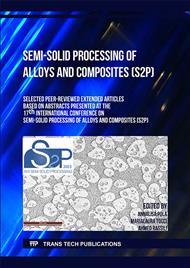p.33
p.39
p.47
p.55
p.61
p.69
p.75
p.83
p.89
Producing Structural High Integrity Castings with Minimum Carbon Footprint with the Comptech-Rheocasting Process
Abstract:
Structural high vacuum die casting has been growing significantly over the past decades. It is typically done with special (primary type) alloys, special melt treatment practices, high vacuum, a carefully engineered die casting process applying many best practices in our industry. Structural die castings are growing in size and complexity and die casting machines are getting bigger and bigger - and those castings are becoming a significant challenge with current technologies. It was now found that Rheocasting - a process of preparing a semi-solid slurry (with 30-45% solid fraction) that is injected slower and in a laminar way into the cavity, can take structural die casting to completely new heights, enable the casting of parts that would otherwise be impossible to cast and at the same time reduce or eliminate some of the current problems of structural die casting. With Rheocasting, lower purity (secondary) aluminum alloys can be used and excellent properties can be achieved as cast and heat treated (T5, T6/7). Rheocasting has had a breakthrough in the telecom and other industries, but it has now been optimized to become an essential tool in the toolbox of making structural castings. This paper shows the developments that lead to the successful series production of a large (about 4’ long) hinge pillar for an Electric Vehicle (EV). It explains the challenges and how they were overcome, and some of the possibilities of the process regarding alloys, heat treatments and achievable properties. It also shows how Rheocasting can help die casters produce more complex (thin and thick walled) and very large castings with the highest integrity. It can replace structural low-pressure permanent mold (LPPM) castings and reduce wall thickness, improve tolerances and make them more economical. Rheocasting can enable die casters to enter this new market of structural castings including Gigacastings, produce parts previously thought impossible to cast (and on much smaller machines than thought), and expand the growing structural die casting market even faster and further.
Info:
Periodical:
Pages:
83-88
Citation:
Online since:
August 2023
Authors:
Price:
Сopyright:
© 2023 Trans Tech Publications Ltd. All Rights Reserved
Share:
Citation:



